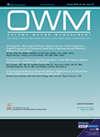Early and Late Closure of Loop Ileostomies: A Retrospective Comparative Outcomes Analysis.
Q2 Nursing
引用次数: 13
Abstract
The optimal timing of loop ileostomy reversal remains largely unknown, but evidence that delayed ileostomy closure may increase postoperative complication rates is increasing. PURPOSE Retrospective research was conducted to compare outcomes between patients who had early (<6 months) or late (>6 months) loop ileostomy closure. METHODS Records of patients >18 years of age who underwent circumstomal reversal of a loop ileostomy over a period of 5 years in 1 hospital's colorectal unit were abstracted and analyzed. Data from patients who had a planned or conversion to laparotomy, a concurrent bowel resection, reversal of double-barrel small bowel and colonic stomas, or closure of an end ileostomy or patients whose records were incomplete were excluded. Demographic information, American Society of Anesthesiologists (ASA) grade, primary operation indication, surgery and inpatient dates, readmission within 30 days of discharge, reasons for readmission, complication type, and Clavien-Dindo classification were extracted and compared between early and late closure groups using independent-sample t test and Fisher's exact test. RESULTS Among the 75 study participants, 25 had an early closure (mean age 68.6 [range 26 - 93] years, mean time since primary surgery 3.8 months) and 50 had a late closure procedure (mean age 71.6 [range 46 - 93] years, mean time since primary surgery 12.8 months). Gender distribution, ASA grades, primary surgery indication, and total number of readmissions were similar between the 2 groups. Hospital length of stay was significantly shorter (5.5 days vs 9.4 days; P = .01) and average number of complications was significantly lower (0.33 vs 0.61; P = .04) in the early closure group. Rates of postoperative ileus, anastomotic bleed, and wound-related complications were not significantly different. CONCLUSION Hospital length of stay and average number of postoperative complications following circumstomal loop ileostomy closure were significantly lower in the early than in the late closure group. Additional studies are warranted to help guide practice.早期和晚期闭合环状回肠切除术:回顾性比较结果分析。
环形回肠造口术逆转的最佳时机在很大程度上仍然未知,但延迟回肠造口术可能增加术后并发症发生率的证据正在增加。目的进行回顾性研究,比较早期(6个月)环形回肠造口术患者的结果。方法对1所医院结直肠病房中年龄>18岁、经5年行环回肠造口术环切翻转的患者的记录进行提取和分析。排除了计划或转为剖腹手术、同时进行肠道切除、双管小肠和结肠造口术逆转、末端回肠造口术闭合或记录不完整的患者的数据。使用独立样本t检验和Fisher精确检验,提取人口统计学信息、美国麻醉师学会(ASA)等级、主要手术指征、手术和住院日期、出院后30天内再次入院、再次入院原因、并发症类型和Clavien-Dindo分型,并在早期和晚期闭合组之间进行比较。结果在75名研究参与者中,25名早期闭合(平均年龄68.6[范围26-93]岁,自初次手术以来的平均时间3.8个月),50名晚期闭合(平均岁71.6[范围46-93]年,自初次外科手术以来的时间12.8个月)。两组患者的性别分布、ASA分级、初次手术指征和再入院总数相似。早期闭合组的住院时间显著缩短(5.5天vs 9.4天;P=0.01),平均并发症数量显著降低(0.33 vs 0.61;P=0.04)。术后肠梗阻、吻合口出血和伤口相关并发症的发生率没有显著差异。结论回肠环造口术后早期患者的住院时间和平均术后并发症发生率明显低于晚期患者。有必要进行更多的研究来帮助指导实践。
本文章由计算机程序翻译,如有差异,请以英文原文为准。
求助全文
约1分钟内获得全文
求助全文
来源期刊

Ostomy Wound Management
医学-外科
CiteScore
0.99
自引率
0.00%
发文量
0
审稿时长
>12 weeks
期刊介绍:
Ostomy/Wound Management was founded in March of 1980 as "Ostomy Management." In 1985, this small journal dramatically expanded its content and readership by embracing the overlapping disciplines of ostomy care, wound care, incontinence care, and related skin and nutritional issues and became the premier journal of its kind. Ostomy/Wound Managements" readers include healthcare professionals from multiple disciplines. Today, our readers benefit from contemporary and comprehensive review and research papers that are practical, clinically oriented, and cutting edge. Each published article undergoes a rigorous double-blind peer review by members of both the Editorial Advisory Board and the Ad-Hoc Peer Review Panel.
 求助内容:
求助内容: 应助结果提醒方式:
应助结果提醒方式:


